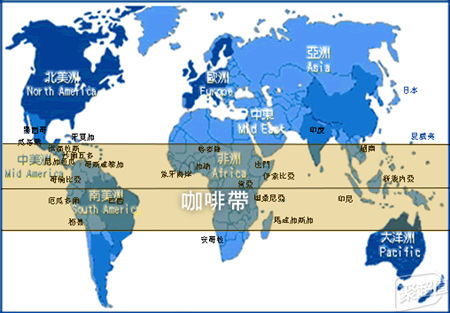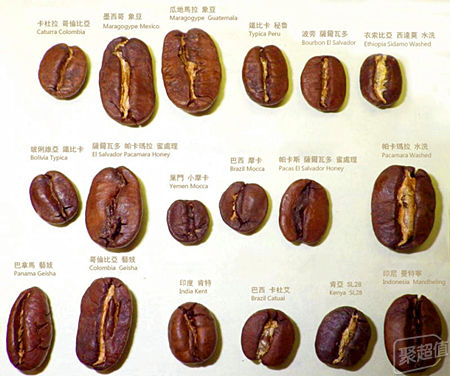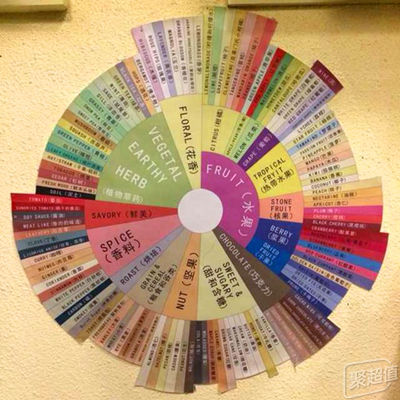Coffee beans choose a quick strategy
Whether you are a fancy coffee lover, a brain powder lover, or a siphon, as long as you have fallen in love with the magic drink of coffee and can no longer stand the cheap and low-end experience of instant coffee, and the high cost of money and time in a cafe, it is undoubtedly your ideal choice to buy a bag of coffee beans and brew them yourself.
Speaking of coffee beans, can you imagine their shape? It is composed of two oval seeds relative to each other, and the connected side is a flat joint called flat bean, but there is also a round seed called round bean, which tastes no different. There are many varieties of coffee beans, some sour, some sweet, some bitter, and some have some special aroma. Coffee beans grown in different regions have different tastes. When you buy coffee beans, you should not only look at the brand information, but also pay special attention to its origin.

The general process of coffee production
The production process of coffee beans:
1. Find the coffee tree in the place of origin and pick the coffee fruit from it.
2. Peel off the peel and pulp of the picked coffee fruit after sun or water washing, and get the raw coffee bean.
3. Roast raw coffee beans and get different grades of cooked beans according to different techniques.
4. Grind the cooked beans into coffee powder and put them into the coffee machine to produce water.
5. Finally, add milk foam to make coffee with various flavors.
Origin of coffee beans:
Coffee beans are processed from the fruits of coffee trees and are generally grown in tropical and subtropical regions. The best quality coffee beans in the world are produced in Indonesia and Colombia. In terms of production, Brazil ranks first in the world's output, accounting for about 30%, followed by Colombia-centered Central and South America, followed by Africa and Arabia, and the remaining 10% are distributed in Asia and the islands.
Different grades of coffee beans can be produced by different roasting techniques and time, such as drum baking and hot air baking:

Generally speaking, if the frying time is short, the color of the coffee beans will be light brown and sour; if the fried tones are dark, the bitterness will be enhanced and the color will be dark brown. Therefore, the baking of coffee beans is divided into several different degrees: 1, very shallow fried company; 2, shallow fried company; 3, shallow fried accompany; 4, shallow fried accompany; 5, medium fried accompany; 6, medium and deep fried accompany; 7, deep fried accompany; 8, very deep fried accompany.
Since a single coffee bean lacks the complex flavor necessary to make a delicious cup of coffee, the coffee beans sold on the market are mixed and packaged with three or seven different types of coffee beans. In general, those who have high attainments in coffee (that is, baristas) will artistically mix each kind of coffee beans according to their characteristics to create a flavor that is generally popular.
There are about 40 species of coffee plants, but the only coffee beans with real commercial value are "Arabica", "Robusta" and "Liberica (Liberia)". Arabica is currently the largest major variety of coffee beans, accounting for about 80% of the output, and its aroma and quality are excellent; Robusta is mostly used to make instant coffee because of its poor quality; Liberica is rarely mentioned because of its quality and low yield.
Here is a mention of "new and old" coffee beans. The "new beans" refer to the coffee raw beans harvested that year, the "old beans" refer to the coffee raw beans produced the year before, and the "old beans" refer to the raw beans harvested earlier. Only the new beans produced in that year are high-grade products, because the taste and aroma of new beans are relatively rich.


In addition to the three original species, each of them can be subdivided into more variety branches. Among them are Brazil Santos, Columbia Grand Class, Jamaica Blue Mountain, Hawaii Kona, Kenya coffee beans, Costa Rica Tara beads, Yega Chefe, Sumatra Manning, Papua New Guinea, Guatemala Antigua, Zambia coffee beans and other coffee beans classification.
It can be divided into different grades according to the elevation of the cultivated land. Generally speaking, the quality of highland beans is better than that of lowland beans, and the price is higher because of the increase in freight.

Generally available in the market are raw beans, cooked beans, coffee powder three forms of coffee. Of course, it is recommended to buy coffee cooked beans, after all, for raw beans, cooked beans have been made by various senior roasters, the quality will not be so bad, if they do not have very advanced technology in this area, do not try to buy raw beans, the price of special roaster is also very high. On the other hand, coffee powder thinks that it has a large area of contact with the air, which itself has a large degree of flavor loss, and it tastes less delicious than coffee and ripe beans.
When it comes to flavor, when you are shopping, you always want to find the kind of smell you expect. It must be difficult to express it verbally. After all, human beings have the poorest description of olfactory words. At this time, we need the help of coffee flavor wheel. This is a judgment from the American Special Coffee Association.

With the help of this tool, you can tell the coffee seller what you want to look like, and it is convenient to buy what you like.
The next point is, how to buy good coffee beans?
1. Look: grab a handful of beans in your hand, about 10, and observe each coffee bean with your eyes. A good shape is complete and full, on the contrary, the shape is incomplete.
2. Smell: put the coffee beans in front of your nose and smell them. The good ones smell strong, while the good ones are tasteless or have a bad smell.
3, pressure: good fresh coffee beans are pressed fresh and crisp, and the fragrance floats out when they crack, otherwise it takes a lot of effort to crush them. Then observe the color of the skin and inner layer of coffee beans, which directly affects the aroma and taste.
4. Color: yellow coffee beans, coffee brewed with sour taste, dark black coffee beans, coffee brewed with bitter taste
5. Chewing: put one or two beans into your mouth and chew. If the beans are crisp and crisp, it means the beans are not wet.
Note:
1. If you don't know how to roast coffee beans, you can choose medium or so roasted beans, because they are more suitable for most coffees and suit everyone's taste.
2. in general, the shelf life of raw coffee beans is one to two years, the shelf life of cooked beans after roasting is within one month, and it is used up within the shelf life after purchase.
3. Go to a well-known brand store to avoid buying bargains at high prices
4. it depends on the origin of the coffee beans on the famous brand, some of which are not necessarily from the place of origin (mentioned many times before).
The importance of choosing coffee beans: the taste is not good, and the coffee machine is just a decoration.
Important Notice :
前街咖啡 FrontStreet Coffee has moved to new addredd:
FrontStreet Coffee Address: 315,Donghua East Road,GuangZhou
Tel:020 38364473
- Prev

Starbucks Yunnan Coffee beans are listed in China
Yunnan coffee is lit this year! Yesterday, Starbucks' 2017 Yunnan Coffee Origin Tour was fully launched; in fact, as early as the annual meeting of Starbucks Shanghai support Center, Starbucks China CEO Wang Jingying excitedly announced another milestone of Starbucks China's Yunnan project: starting from February 2017, the trip to Yunnan Coffee Origin will be officially launched. Yesterday, the reporter
- Next

The disturbance in Coffee-Starbucks Price rise in Taiwan
This week, the price of Starbucks coffee at Taiwan's Unification convenience store went up, with 29 drinks up 5-20 yuan (NT $, the same below), an average increase of 8%, with the highest increase of 16%. This has made headlines in Taiwan's livelihood this week, and the economic observation and social analysis around the rise in coffee prices are intriguing. Taiwan can be called the island of coffee, and convenience stores throughout villages and towns make coffee smell to remote places. Like Taipei and Taiwan
Related
- Being chased out of the rain in front of Starbucks?! Store: Sheltering from rain under umbrellas poses a safety hazard
- The white moonlight has changed?! Lucky launches "Big Winter Pear American"
- Hand-brewed coffee three-stage method, high-sweet and universal brewing method to share! What does the high sweet water level of hand-brewed coffee mean?
- What is the difference between raw, refined and full espresso coffee? How to extract espresso and taste good?
- A complete list of coffee bean names and their meanings! What is Yejia Shefi coffee? Where is Mantelin coffee?
- What grade does Arida Manor Kaduai coffee beans belong to? What treatment is Arida ASD slow anaerobic sun exposure?
- The milk tea cup becomes smaller?! Overlord Tea Girl launches a new "Return to Yunnan" series
- Accused of selling counterfeit and high-priced coffee beans! Well-known boutique coffee brand "Oukelao" bowed and apologized!
- How to make espresso dumplings? Can I eat coffee and glutinous rice balls together?
- Save the unformed and stagnant powder cakes in one second! What is the problem with stagnant water in the powder bowl of the espresso machine?

